May 9, 2014
Air Date: May 9, 2014
FULL SHOW
SEGMENTS
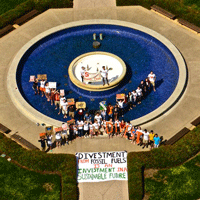
Stanford Divests from Coal
View the page for this story
Stanford University has given the divestment movement a huge boost by promising to pull their 18 billion dollar endowment from coal companies. Student activist Michael Peñuelas tells host Steve Curwood that he’s proud of his University, but the students will keep pushing for divestment from all fossil fuels. (06:00)
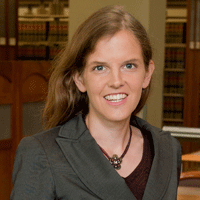
Texas Family Wins Fracking Suit
View the page for this story
A Texas family just won a $3 million dollar lawsuit against a natural gas company, arguing that the company’s fracking operation was a nuisance to their life. Host Steve Curwood asks Florida State law professor Hannah Wiseman if this could be a turning point in the legal battle against fracking's environmental effects. (06:05)
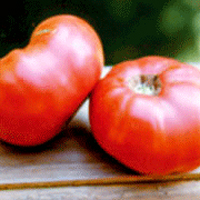
Pesticides on Produce
/ Bobby BascombView the page for this story
An apple a day may keep the doctor away but it often comes spiked with a cocktail of chemical pesticides. The Environmental Working Group has released its annual dirty dozen list of the fruits and vegetables with the most and least detectable pesticide residues. Living on Earth’s Bobby Bascomb reports. (05:40)
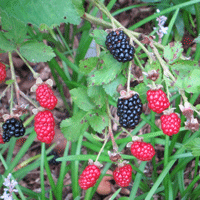
Gardening for Climate Change
View the page for this story
From vicious drought to terrible storms, climate change is affecting people throughout the world. Writer Jim Barilla sees that climate change is being felt in his own urban garden in South Carolina. He tells host Steve Curwood how climate disruption has changed his gardening practice. (06:10)

Bittersweet Nightshade
/ Ari DanielView the page for this story
Across the country, non-native species are taking root. Some, like kudzu or Japanese Knotweed, smother the local flora, but not all. As Ari Daniel reports, scientists are working out what soil conditions make some invasives so succesful. (05:40)
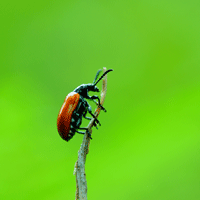
Evolution in the Age of Mass Extinction
View the page for this story
From climate change to habitat destruction, humans are causing species to die out at alarming rates all around the world. But as biologist Chris Thomas tells host Steve Curwood, the pressure on ecosystems today is also leading to a surge in adaptation and evolutionary diversity. (13:45)

Beyond the Headlines
View the page for this story
In our weekly trip beyond the news headlines Peter Dykstra tells host Steve Curwood about a pipeline company that argues oil spills are good for local economies, and a fire retardant chemical being removed from some soft drinks in the US. (04:15)
Show Credits and Funders
Show Transcript
HOST: Steve Curwood
GUESTS: Michael Penuelas, Hannah Wiseman, Jim Barilla, Chris Thomas
REPORTERS: Bobby Bascomb, Ari Daniel
[THEME]
CURWOOD: From Public Radio International, this is Living on Earth.
[THEME]
CURWOOD: I’m Steve Curwood. The fossil fuel divestment movement gets a big win as Stan-ford University decides to purge coal from its endowment. Student campaigners call it great pro-gress.
PENUELAS: Students have been arrested on the campuses of Harvard and Washington Univer-sity for the same push. So, you know, in light of that, when you look at it from that kind of jux-taposition, quite fantastic.
CURWOOD: Also, how to garden in a time of climate change. And there's a new list of the most pesticide laden fruits and vegetables, but shoppers in the produce aisle have their own ideas.
WOMAN 1: I think berries would be at the top of the list.
MAN 1: I would expect the softer greens. I would expect perhaps spinach.
WOMAN 2: I would guess like bell peppers.
MAN 2: I'd guess like maybe root vegetables potatoes, sweet potatoes, yams. Stuff like that?
CURWOOD: The answer and more this week on Living on Earth. Stick around.
[NEWSBREAK MUSIC: Boards Of Canada “Zoetrope” from “In A Beautiful Place Out In The Country” (Warp Records 2000)]
ANNOUNCER: Funding for Living on Earth comes from Stonyfield Farm, makers of organic yogurt, smoothies and more.
Stanford Divests from Coal
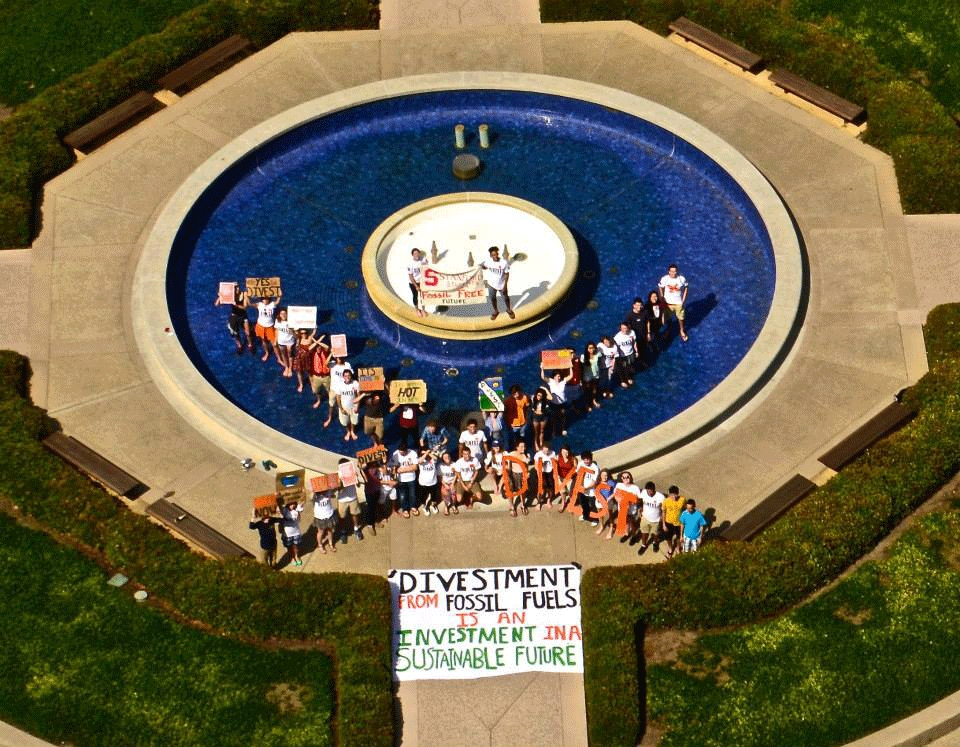
Stanford’s student activists demanding their school divest from fossil fuels (photo: Fossil Free Stanford)
CURWOOD: From the Jennifer and Ted Stanley Studios in Boston and PRI, this is Living on Earth. I’m Steve Curwood. Stanford University will divest its $18 billion endowment of holdings in coal companies - a major victory for the rapidly growing fossil fuel divestment movement. Stanford is the first major university to acknowledge its investments contribute to climate disrup-tion, and it joins 11 colleges, and a number of cities and foundations that have already divested.
The announcement came within days of the arrest of students demanding divestment at Washing-ton and Harvard universities. Stanford President John Hennessy called moving away from coal investments ”a small but constructive step” and pledged to keep working to develop viable sus-tainable energy solutions for the future. Well, divestment activists are thrilled. Stanford junior Michael Penuelas, a lead student organizer, explained how the breakthrough happened.
PENUELAS: Stanford's Board of Trustees passed a vote with a majority sufficient to divest Stanford from coal, so what that means is they're going to cease all direct investments in pretty much a list of about the 100 biggest coal companies. They're not going to make any future in-vestments in those either.
CURWOOD: What about mutual funds that have coal? Maybe just as a small part?
PENUELAS: Yes, so mutual funds and indices make up the majority of Stanford's endowment. Big endowments in general are going to be under various contractual obligations, so they can't just go ahead and divest immediately, is what it sounds like to us, but they're going to go ahead and pressure those as strongly as they can to go ahead and do what they can, those external asset managers, to pull Stanford's money out.
CURWOOD: To what extent were you inside the room during this assessment by Stanford on the question of divestment?
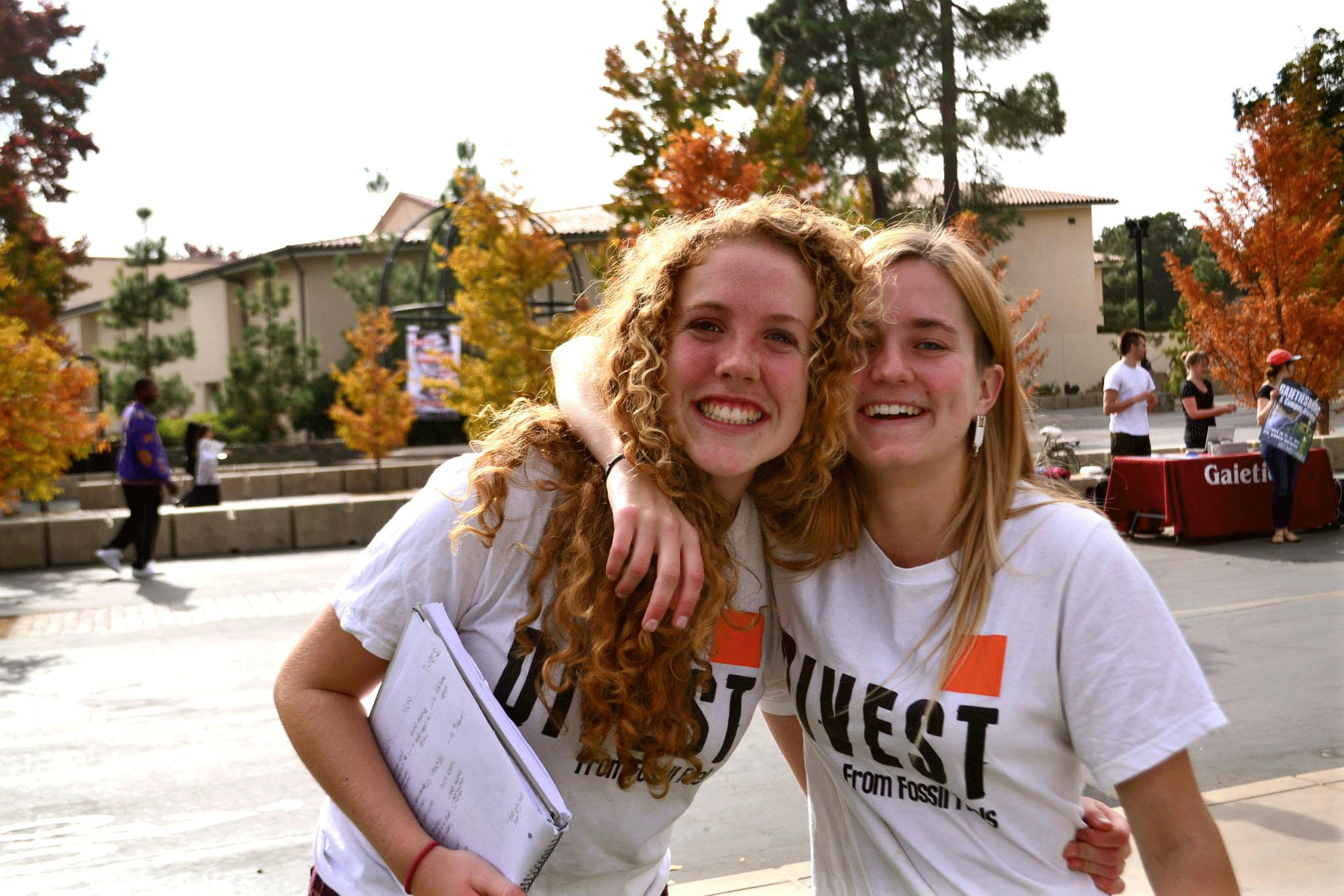
Stanford student activists (photo: Fossil Free Stanford)
PENUELAS: So our campaign submitted a formal request for review to an advisory panel com-posed of faculty, staff, students and alumni as well last spring. Since then, we've met with vari-ous elements of that panel and other administrators about once every two weeks, or once a week, while they've been conducting an extensive research and deliberation process. About two weeks ago, they notified us that it had passed on to the Board of Trustees. There's a subcommittee there that then made a bigger recommendation to the board itself.
CURWOOD: What was your dialogue like with the university through this process?
PENUELAS: Very amiable and very constructive. We've actually been struck particularly when you look at the actions that other administrations have taken. For example, in the last week or so, students have been arrested on the campuses of Harvard and Washington University for the same push. So, you know, in light of that, when you look at it from that kind of juxtaposition, quite fantastic.
CURWOOD: Now, your group, Fossil Free Stanford, was calling on the university to divest from all fossil fuels. How satisfied are you with this step?
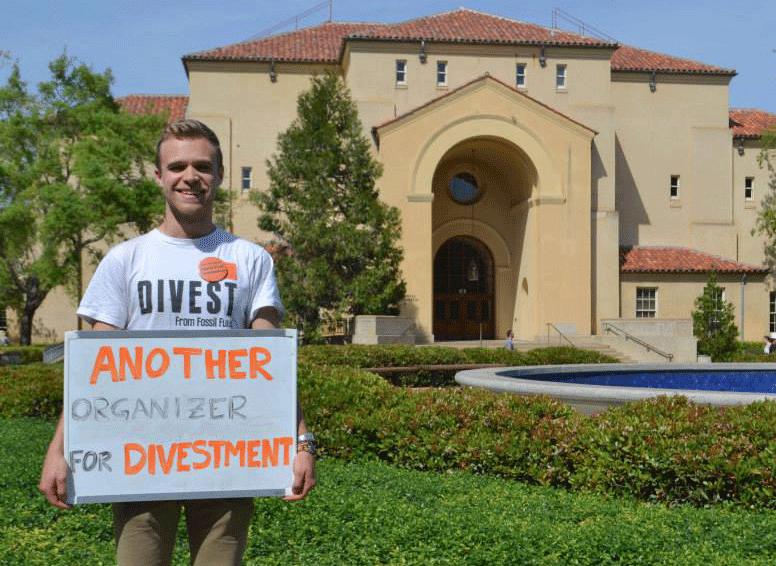
Michael Peñuelas, Junior at Stanford (photo: Fossil Free Stanford)
PENUELAS: We're pretty proud of Stanford. This marks the biggest endowment, $18.7 billion, that is now off the table when it comes to investments in coal. We'll certainly keep pushing be-cause tar sands is just as dirty as coal when it comes to carbon, but also oil and natural gas, they're also contributing enormously to climate change, and it's largely a similar group of com-panies that are controlling those reserves. And what Stanford made its decision on was the fact that the climate change caused by coal is causing substantial enough --"social injury" was the wording that they used, to warrant action on those investments. And in our opinion, all of the other drivers of climate change are also causing that same social injury. We're going to keep this dialogue going, we're going to keep working with this review panel, this advisory panel, and ul-timately, we're going to really hope for divestment. And this is a promising sign.
CURWOOD: Now, a cynic might say that's Stanford's move was simply a smart financial move given how coal stocks have fallen. The biggest company, Peabody Coal, was $75 just three years ago, $75 a share, and is now down in the teens.
PENUELAS: I certainly think that was a major factor in Stanford's decision. Fossil fuels, as car-bon legislation rolls out across the globe and as people realize that there are feasible alternatives, are going to decrease in value. There's this concept of a carbon bubble that's being discussed widely in financial circles right now, and so I think frankly, I think it makes good financial sense. There have been some studies that have shown if universities had divested ten years ago, they would have significantly higher returns today. It's just fact these industries are on the way out, coal particularly in the US, but all of these fossil fuel industries. So, I think that's a perfectly good reason. If universities want to divest - on financial grounds - then you know what, that's good by me.
CURWOOD: How much money do you think Stanford had invested in coal when this ruling went down?
PENUELAS: Stanford being a private institution, they don't have to disclose where their invest-ments go for the most part - and they don't - but President John Hennessy did state that it’s not a very big chunk, the direct investments they're going to rid themselves of immediately. So it's not the biggest financial impact that it could have been, but it's certainly something, and more than anything it's certainly a symbolic statement that Stanford on an institutional level is done with coal. Coal, it's the most carbon-intensive fossil fuel. The largest fossil fuel reserves on Earth are coal reserves, and it's the fossil fuel with the most rapid increase in the rate of exploitation in countries around the world, so a move away from coal on the part of Stanford is a leading and a really major step in the move away from the fossil fuel industry.
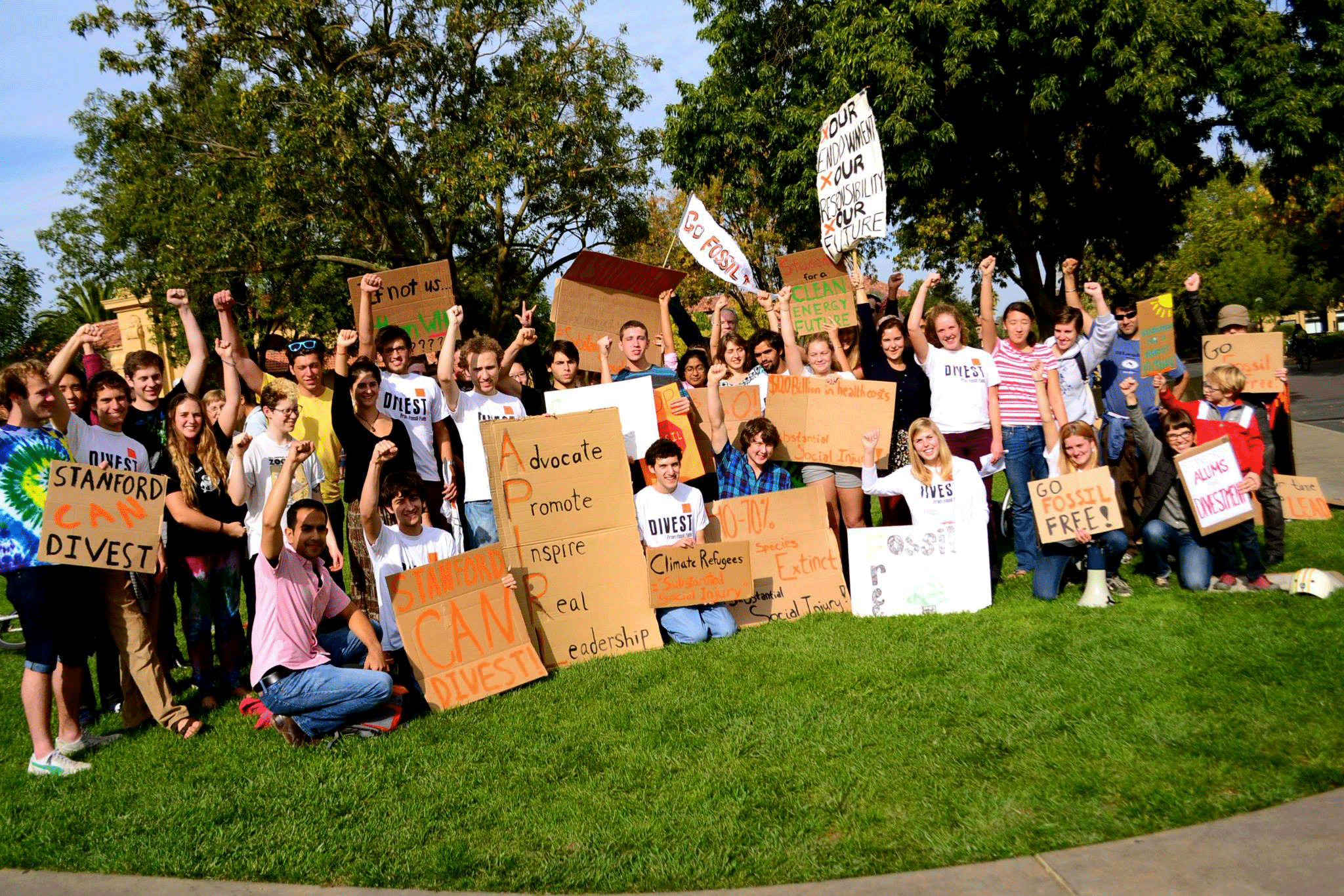
78% of the Stanford student body supports full fossil fuel divestment (photo: Fossil Free Stanford)
CURWOOD: What's the importance of this coal divestment by Stanford in terms of the national divestment movement, do you think?
PENUELAS: The responses we've been getting on Facebook and other forms of social media as well as a hundred emails we've received so far from other student organizers have been ecstatic. This is one of the first really big wins. This is 18.7 billion reasons why we need to keep moving, and we need to keep pushing. So a lot of those campaigns are galvanized by this because espe-cially in the light of, again, these arrests at Harvard and Washington university have been really depressing and a sad week for the movement, because these universities chose instead of opening dialogue with their students to arrest them. So I think this comes at a very important time, and this is going to be a very crucial action when we look back at this movement in the future.
CURWOOD: Michael Penuelas is a junior at Stanford University and a lead student organizer for the Fossil Free Stanford movement. Michael, thanks so much for taking the time today.
PENUELAS: Yeah, I really appreciate your time. Thank you.
Related link:
Fossil Free Stanford
Texas Family Wins Fracking Suit
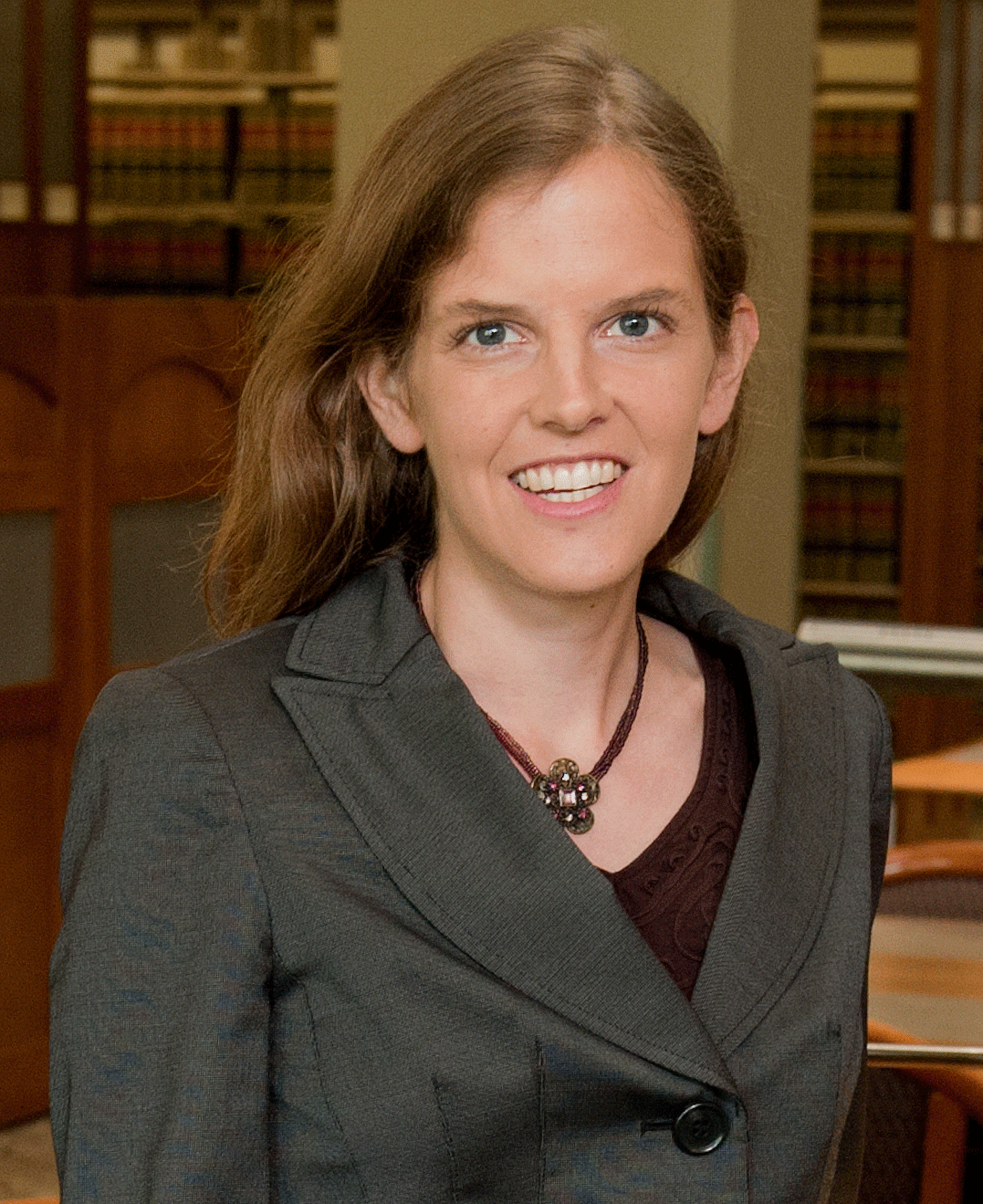
Hannah Wiseman (photo: Florida State University School of Law)
CURWOOD: Divestment isn't the only environmentally based threat to fossil fuel companies. While many tout the natural gas fracking boom as a huge benefit, some residents abutting those gas wells say they're suffering from polluted water, toxic chemicals and bad air. Many have sued. Suits have been dismissed, or settled but in late April the Parr family in North Texas won a rare victory. They sued several companies over numerous health problems they blame on the foul air from a nearby gas well. All the companies settled, except for Aruba Petroleum. When the case went to trial the Parr family won nearly $3 million dollars in damages. Hannah Wiseman teaches environmental and energy law at Florida State University and joins me now to discuss the issues. Welcome to Living on Earth.
WISEMAN: Thank you. Thank you for having me.
CURWOOD: Now so far we haven't seen too many legal victories and cases involving fracking. How was the Parr family in Texas able to convince a jury to award them $3 million dollars in damages?
WISEMAN: The Parr family alleged a nuisance, which is an unreasonable interference with the enjoyment of their property. And they persuaded the jury that various health problems were caused by oil and gas activities occurring near their property.
CURWOOD: What did they show in terms of the nuisance and their health problems?
WISEMAN: The Parr family showed dizziness, nausea, possibly immune effects, lymph nodes enlarged on the necks. They had reports from blood tests suggesting changes to their health that occurred after oil and gas activity began. Also damage to their livestock, and damage to livestock is another actionable claim with respect to a nuisance because that is another interference with their property.
CURWOOD: I imagine that's big in Texas too.
WISEMAN: That's correct.
CURWOOD: To what extent are nuisance claims being used by plaintiffs in other fracking cases around the country?
WISEMAN: Nuisance claims are very common. They're one of the most common types of claims because these are common law claims, meaning they were developed by courts, and they exist above the public law of statues. Even if a defendant complied with all statues and regula-tions, including environmental statues and regulations, plaintiffs may still allege a nuisance.
CURWOOD: Now, how unusual is it for a case like this to wind up at trial? One would think that the gas and oil companies would prefer to settle a case like this out of the public eye.
WISEMAN: This is very unusual. Most cases have indeed settled or been dismissed. This is one of the first, if not the first cases to go to trial on the issue of nuisance associated with oil and gas, and particularly hydraulic fracturing.
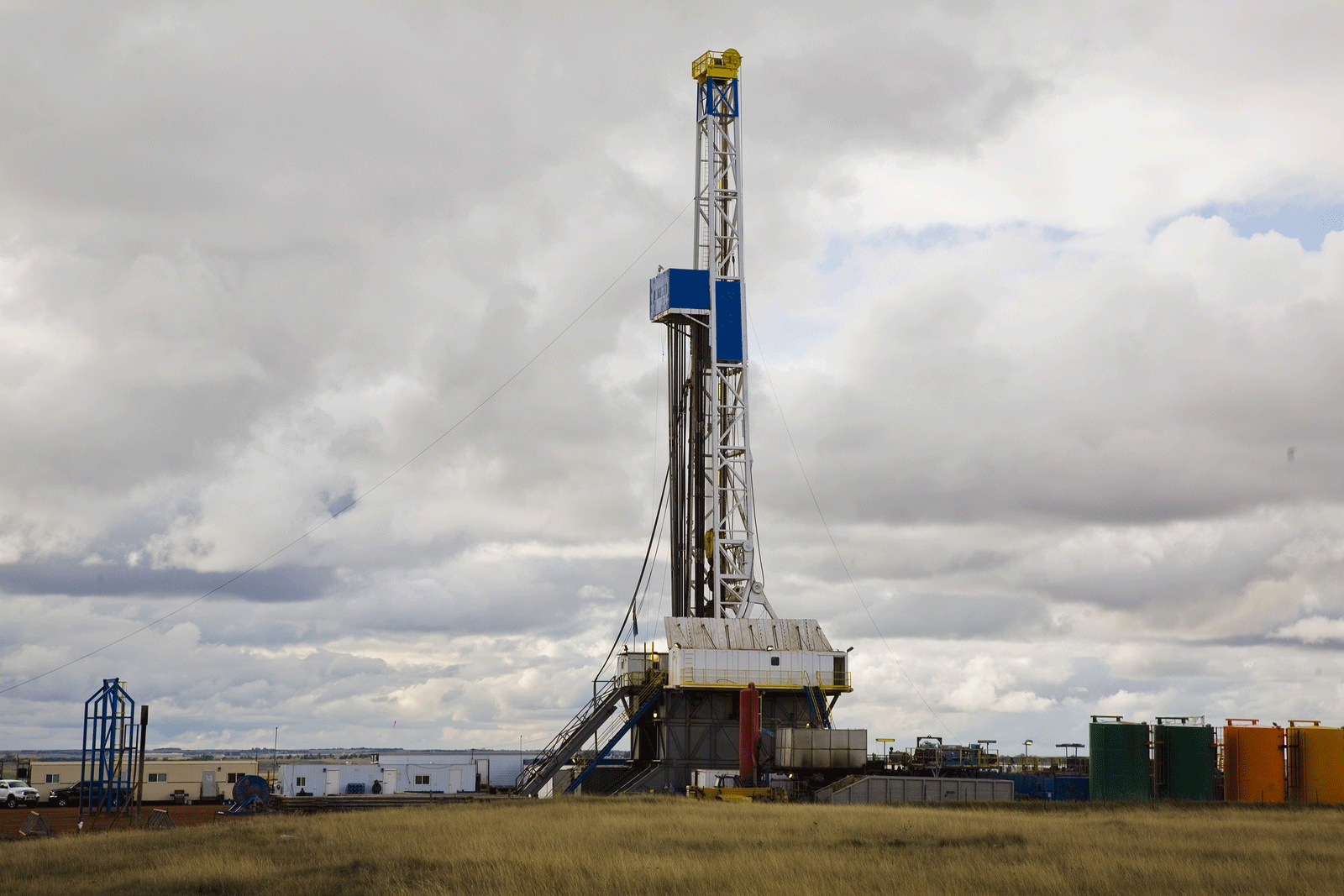
Midwest natural gas extraction (photo: bigstockphoto.com)
CURWOOD: What other jurisdictions recognize this nuisance concept?
WISEMAN: All jurisdictions within the United States recognize some form of nuisance. This claim was originally developed in the English courts. There were very early cases finding that agricultural activities were a nuisance. The nuisance claim was then transferred to the United States, and has since been recognized in US courts. In some cases, legislatures have further de-fined or narrowed what a nuisance claim can be, but this claim is alive and well throughout the United States.
CURWOOD: I wonder how applicable this is to somebody living downwind from a hog farm, for example?
WISEMAN: That was indeed the original nuisance case. Aldred's case in England was about a hog farm, and the neighbor of the hog farm successfully argued that the odors from the farm were so strong as to make the neighbor's property uninhabitable.
CURWOOD: How surprised were you that this fracking, hydraulic fracturing nuisance case, happened in Texas?
WISEMAN: It is somewhat of a surprise because Texas is often viewed as a state that has had such a high level of oil and gas production for such a long time that the activity is accepted by the citizens of the state. There's this view that people in Texas don't tend to complain because they're happy with the profits that oil and gas drilling have brought into the state. But I think es-pecially with the expansion of drilling due to the hydraulic fracturing of shales, I think there's a concern that wells are increasingly close to people's houses. There are more than 1,700 gas wells in the city of Fort Worth alone, for example, and with the proximity of wells to farms and hous-es, there may be growing concerns about the environmental effects.
CURWOOD: How vulnerable do you think this Texas case is to appeal?
WISEMAN: I think the case is somewhat vulnerable on appeal, and I think there could be a number of challenges with respect to whether the activity was, in fact, unreasonable, as well as whether the plaintiff's health problems were caused by the defendant. I think there could an ar-gument that there were other sources of pollution that also contributed to the alleged injuries. In terms of setting precedent, as well as setting an example that other states will follow, I would imagine that this case will not establish strong precedent until it is assessed by an appellate court.
CURWOOD: So, it'll take a while, I imagine, it'll make its way to the Supreme Court?
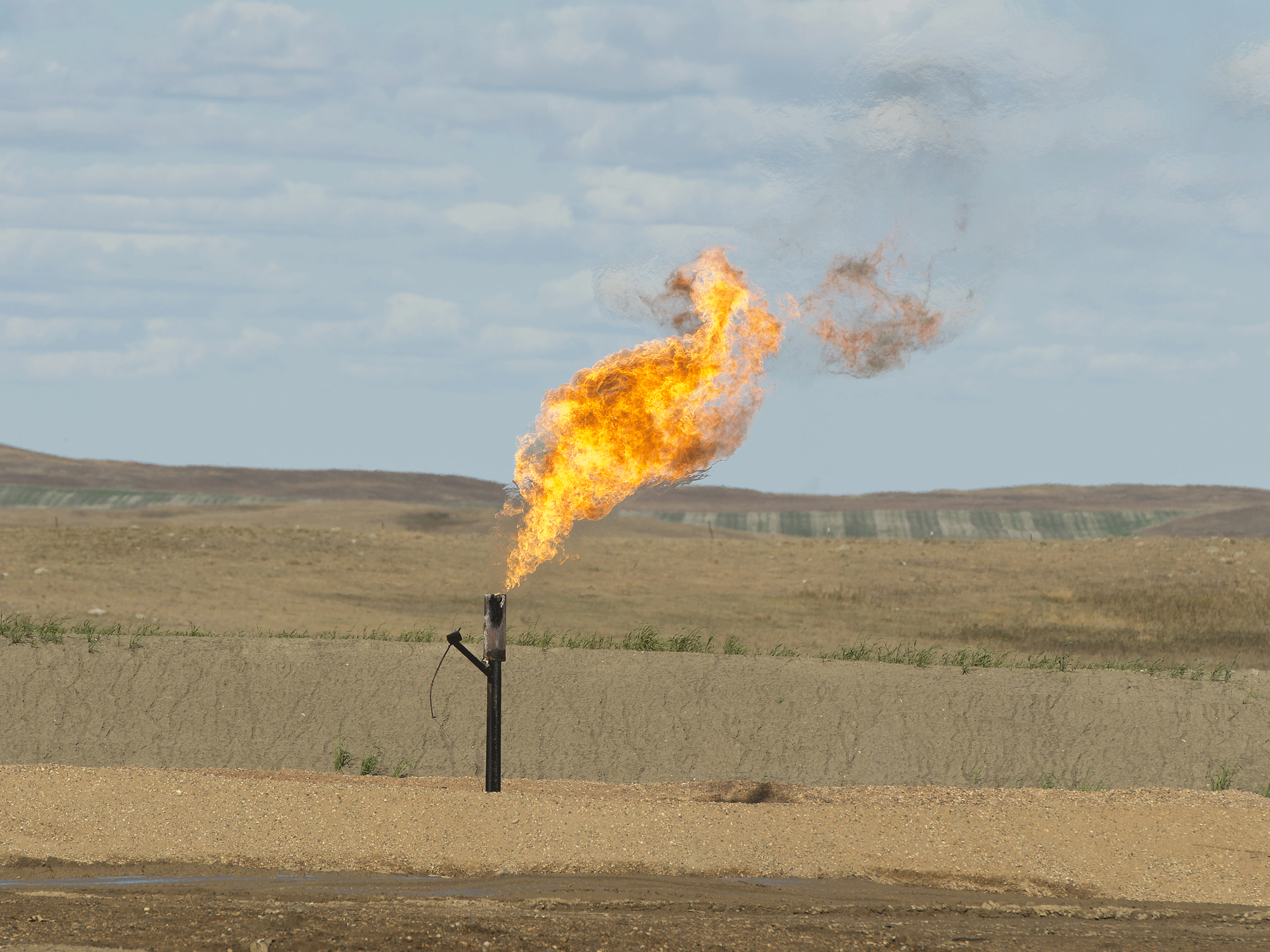
A natural gas flare (photo: bigstockphoto.com)
WISEMAN: My best guess is that it would end up in the Texas Supreme Court because this could be a monumental case both for plaintiffs and for the oil and gas industry, and I think strong arguments will be made by both sides on appeal.
CURWOOD: Hannah Wiseman teaches environmental and energy law at Florida State Universi-ty. Thanks so much for taking the time today, Professor.
WISEMAN: Thank you.
Related link:
Hannah Wiseman teaches law at Florida State University
[MUSIC: ZecaBaleiro “Dez Passos” from Geraldas e Avenacas (Sarava Discos 2014)]
CURWOOD: Coming up...what one gardener did to cope with a climate gone crazy. Keep listen-ing to Living on Earth.
[CUTAWAY MUSIC: The Mulchmen: “Mudslide” from Louder Than Dirt, Thicker Than Mud (Big Beef records 1997)]
Pesticides on Produce
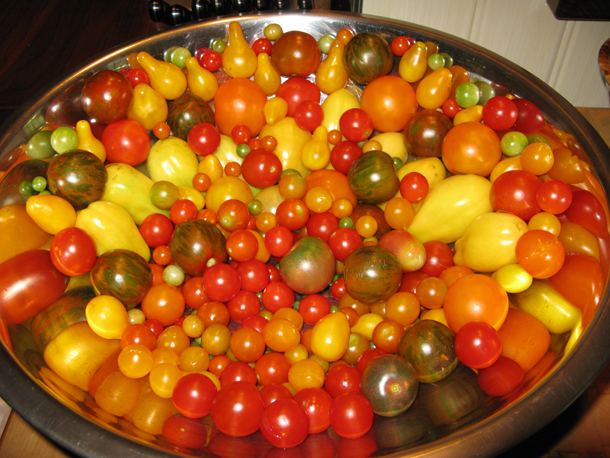
Tomatoes of all colors from Amy Goldman’s garden (Photo: Joanna Rifkin)
CURWOOD: It's Living on Earth, I'm Steve Curwood. Despite the rapid growth of organic food production, pesticides are widely used on America's farms. And as pests become resistant, more pesticides are applied, which can mean more of these risky chemicals show up in the foods we buy. To help guide consumers, the Environmental Working Group is out with the latest version of its annual list of fruits and vegetables with the least and most pesticide residues. Living on Earth’s Bobby Bascomb has more.
[GROCERY CARTS, BEEP BEEP OF REGISTERS]
BASCOMB: 6:00pm on a Tuesday, grocery store rush hour at at my neighborhood market in Cambridge, Massachusetts. People pop in after work to get food for dinner. In the produce de-partment - amid bins of broccoli, piles of oranges, and stacks of bananas I asked shoppers to take a guess…. which item of produce has the most pesticide residue?
WOMAN: I think berries would be at the top of the list. They have such thin skins and they ab-sorb things like that really easily.
MAN: I would expect the softer greens. I would expect perhaps spinach. The softer the leaf the more little pests want to eat it.
WOMAN: I would guess one of the more colorful vegetables. I would guess like bell peppers or something like that because I feel like whenever I read stuff it’s the stuff with the most color is the stuff that’s being artificially messed with.
MAN: I’d guess root vegetables. Stuff like potatoes, sweet potatoes, yams. Stuff like that.
MAN: I think I saw something once that said apples are really high as far as pesticides but that’s the only one I remember.
BASCOMB: He’s right. All of those foods are on the dirty dozen list. However, though an apple a day may keep the doctor away it also comes spiked with a cocktail of 5 different types of chemical pesticides. Apples routinely top the Environmental Working Group’s dirty dozen list but this year the researchers are particularly concerned about a chemical called diphenylamine, or DPA. Roughly 80% of American apples are sprayed with DPA after they’ve been picked to protect the skin of the fruit during shipping. Sonya Lunder is a senior analyst with the Environ-mental Working Group.
LUNDER: Europe actually took action in 2012 to ban this pesticide treatment because they couldn’t guarantee consumers in Europe that this DPA treatment didn’t breakdown to form can-cer-causing impurities or breakdown products when the apples were stored.
BASCOMB: Number two on the dirty dozen list …. strawberries.
LUNDER: Strawberries grow on the ground. They’re very susceptible to pests and spoilage. They’re also a high value crop. So there’s a very aggressive regiment of treating strawberries in-cluding fumigating the soil to kill all living creatures in the soil before they plant the little straw-berry starts.
BASCOMB: And rounding out the top three produce items with the most pesticides, grapes. Leafy greens aren’t off the hook though. Kale and collard greens are frequently contaminated with insecticides known to be toxic to the human nervous system but potatoes have the most pes-ticides by weight. Lunder says that doesn’t mean people should stop eating fruits and vegetables. Instead she advises them to choose organic when possible.
LUNDER: If you have limited money to buy organic foods, focus on those foods that are on the dirty dozen list and when your organic dollars are tight consider the clean 15 as a group of foods that have very few pesticide residues on them.
BASCOMB: Avocados have the least pesticides of any food tested, followed by sweet corn, and pineapple. Researchers test the part of the produce people eat and generally fruits and vegetables with a thick non-edible outer skin have fewer detectible residues.
Most of the shoppers in my grocery store were surprised when I told them about the high con-centration of pesticides on apples and had mixed feelings about buying organic instead.
WOMAN: I’ll be thinking about it but I’ll still probably buy the same food to be honest. I’m poor, so organic is expensive!
MAN: We do eat organic. Pesticides and other reasons - it tastes better, it’s better for you.
MAN: I’m definitely concerned about pesticides and try to avoid non-organic produce when I can. I actually get a farm share most of the year.
WOMAN: I’m kind of the type that’s like it’s worrisome but there’s not much I can do about it.
MAN: I don’t know what to make of it. I mean I wash everything pretty thoroughly anyway so…
BASCOMB: (on tape) This report, actually the way they did it, they washed everything very thoroughly and then they tested it so this is the pesticides that you can’t wash off.
MAN: Well, that’s upsetting….
BASCOMB: The pesticides USDA and FDA researchers found in the study can’t be removed by washing the food. The shoppers I talked to were left wondering if eating pesticides on produce is safe. Sonay Lunder from the Environmental Working Group says there’s no ethical way scien-tists can test the safety of people consuming pesticides. But several studies have examined the health outcomes of children who live in farming communities and were exposed to pesticides.
LUNDER: These long term studies of American kids found that kids with the higher levels of exposure to these pesticides had lower IQs and had signs that their brain and nervous system de-velopment had been altered or disrupted from the pesticides. And in the IQ studies - it’s like a 6 point IQ drop which is equivalent to lead poisoning.
BASCOMB: Lunder says the children in the farm study were likely exposed to more pesticides than the residue in the food we eat. However, young children and pregnant women are still most at risk for problems associated with pesticides so she advises people buying for those groups to be extra choosy in the produce department of the grocery store.
For Living on Earth I’m Bobby Bascomb in Cambridge, Massachusetts.
Related link:
EWG’s Shopper’s Guide to Pesticides in Produce
[MUSIC: Tommy McCook “Green Mango” from Top Secret (Beatville Records 1999)]
Gardening for Climate Change
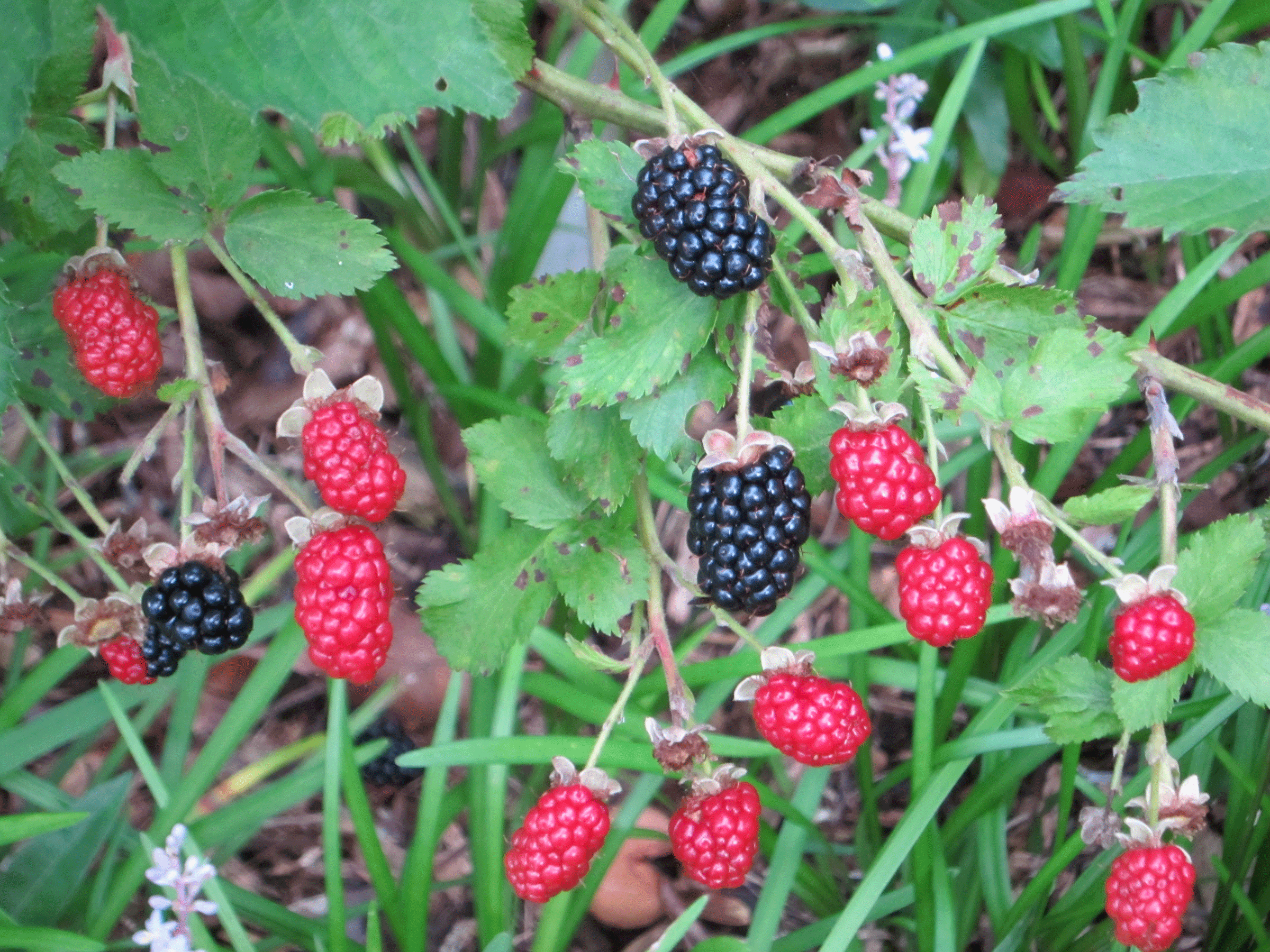
Jim Barilla and his family eat from the garden they keep in their own backyard (photo: Jim Barilla)
CURWOOD: The White House has just released its third National Climate Assessment showing that every region of the country is already affected. Higher temperatures, rising sea-levels, more intense storms and wildfires and huge swings in temperatures are a reality, and we no longer know what's normal. All this climate disruption affects just about every way we live, including how we garden. Author Jim Barilla recently wrote an essay in the New York Times called, Gar-dening for Climate Change. So we called him up to get some ideas.
BARILLA: For me, climate change up until recently seemed theoretical and futuristic and really kind of disconnected from what I was doing on the ground locally in my own yard. But recently, I've started to see tangible changes that make me question whether this is kind of the new nor-mal. This winter I think the thing that got me really thinking about this was the experience of the polar vortex in which we had successive waves of very unusual cold followed by sort of normal warmth. And observing the impact that that had on plants and insects and other creatures that live in our yard was disconcerting and had me sort of out there putting frost blankets over every-thing one week and pulling them off and watching things come into bloom only to watch them freeze – it was a whipsaw of weather back and forth here.
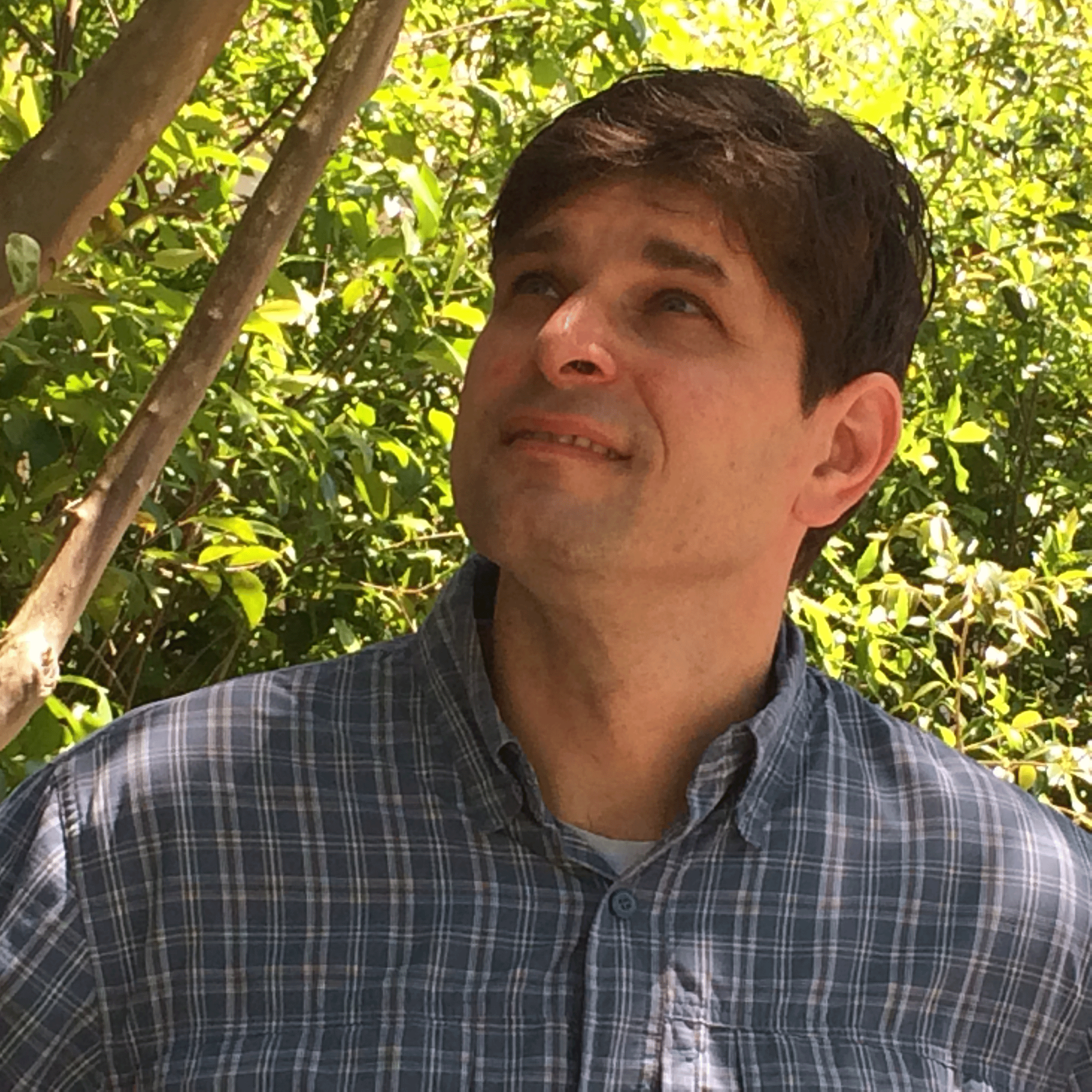
Jim Barilla in his garden (photo: Nicola Waldron)
CURWOOD: So how do you think climate change is affecting your practice of gardening? What do you do different in the garden now?
BARILLA: Well, I think that's an open question, and I'm still trying to figure that out. What's intriguing to me is that, I think, once you sort of recognize that climate change is going to have a tangible kind of effect on your practice in the yard, then you start to think about those pragmatic questions. Well, what am I going to plant, when am I going to plant, what can live here?
One thing that was interesting to me, and this happened somewhat by happenstance, is that I had planted about 10 different cultivars of blueberries in our yard. These are adapted to different cli-mate zones, so some of these have been developed to grow well, for example, in the mid-Atlantic states, others were developed to grow well in Florida, and really what that means is that they have different chilling requirements. They require a period of cold weather to reset their internal clock and tell them when to bloom. The ones with low-chilling requirements will come into bloom relatively early, the ones the higher chilling requirement will come into bloom later.
What that meant this year was that the cultivars developed for Florida were coming into bloom in early January, and just getting hammered by the freezing weather. The ones that were developed for more northerly climate actually came through pretty well. So we now have fruit on the nor-therly varieties, the southern varieties don't have much this year, and I think that might be what I'm thinking in terms of is planting a much broader spectrum of species and really trying to en-courage that kind of local diversity on a microcosm level, to think of the yard as a microcosm, but also as a connecting the small yard to the continental and the global kind of questions of spe-cies diversity.
CURWOOD: Now, in your essay, your recent essay, you used a phrase "extreme gardening" to describe what you're doing. What do you mean by that?
BARILLA: Well, to me, what that means is, again, I'm planting a lot more species, a lot of more different things, and also I think, challenging the notion of what belongs where. Typically, if you're going to create wildlife habitat, one of the things you're encouraged to do is to add a lot more native species to the landscape, and that's certainly something that I've done here. But it also strikes me that if something as fundamental as the climate is changing, then that has deep implications for what we consider native and non-native and what can live in various environ-ments, and one way I think to avoid despairing about what's happening is to think, well, what can I do to help the species survive? And so this plant may not be native here, but at the same time, it's not invasive, is it possible I could encourage it to live here, what could live on it, are there communities of species that could inhabit this urban environment and make it a more diverse place, bearing in mind that what we do in the city might not be what we'd want to do in Yellow-stone National Park. The city is already a highly mediated environment, the soils are different, the temperatures are already different, so we have a kind of place where we can experiment with what's going to work in the future, and to me there are some exciting possibilities along those lines.
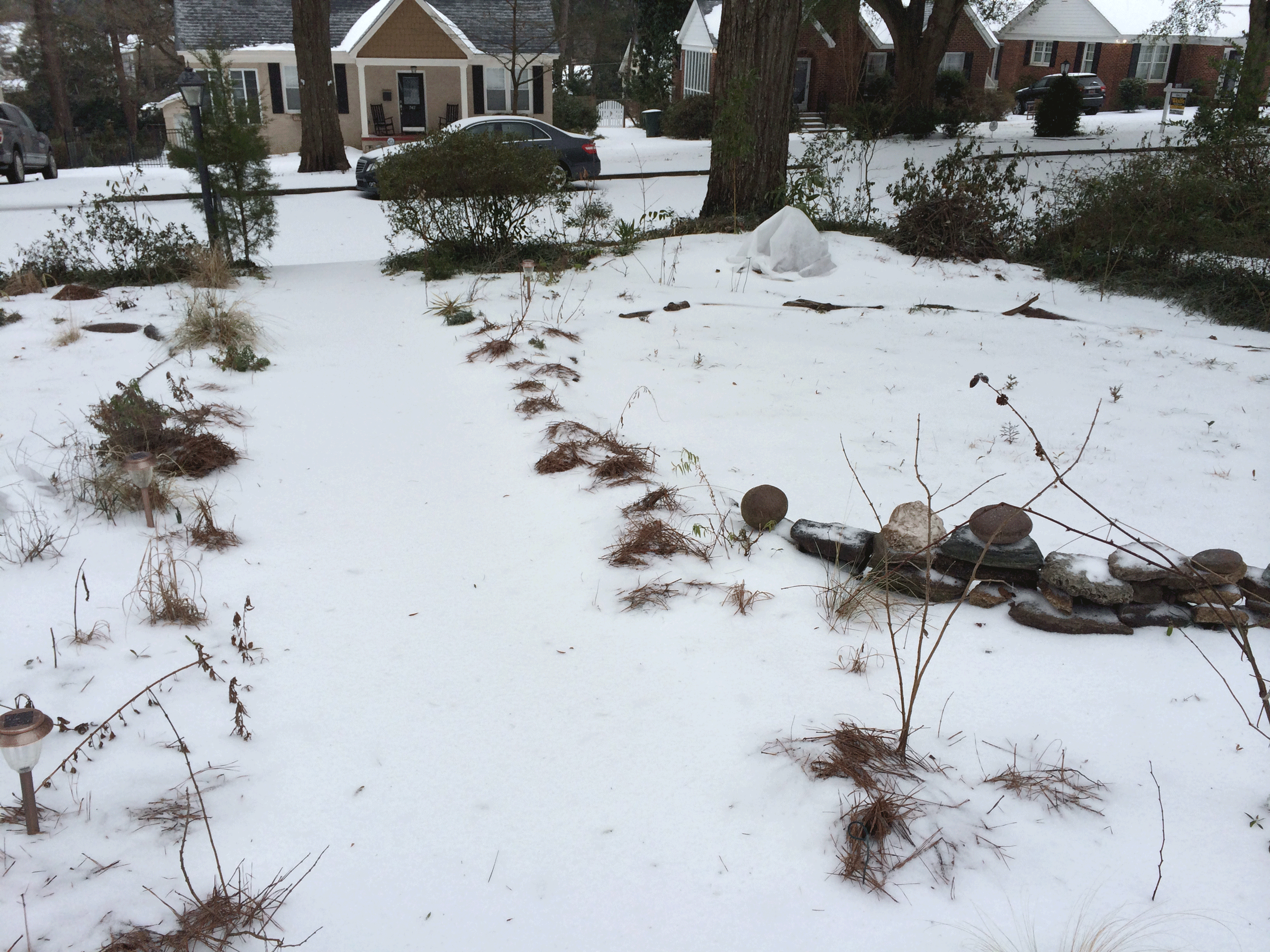
The backyard in the depths of winter (photo: Jim Barilla)
CURWOOD: Jim, what do you think of the term, invasive species?
BARILLA: What I would like to see us do is have a more nuanced approach to how we label species. "Invasive" is something I think we can distinguish from "non-native", so I think we can consider them on a species by species approach, and we can distinguish from something like the honeybee, which is a non-native species, very important ecologically as well as agriculturally in our environment. If we use the term non-native, we can sort of think, well, it may be non-native, but it may actually be beneficial or it may not be doing us any harm, or doing the environment any harm.
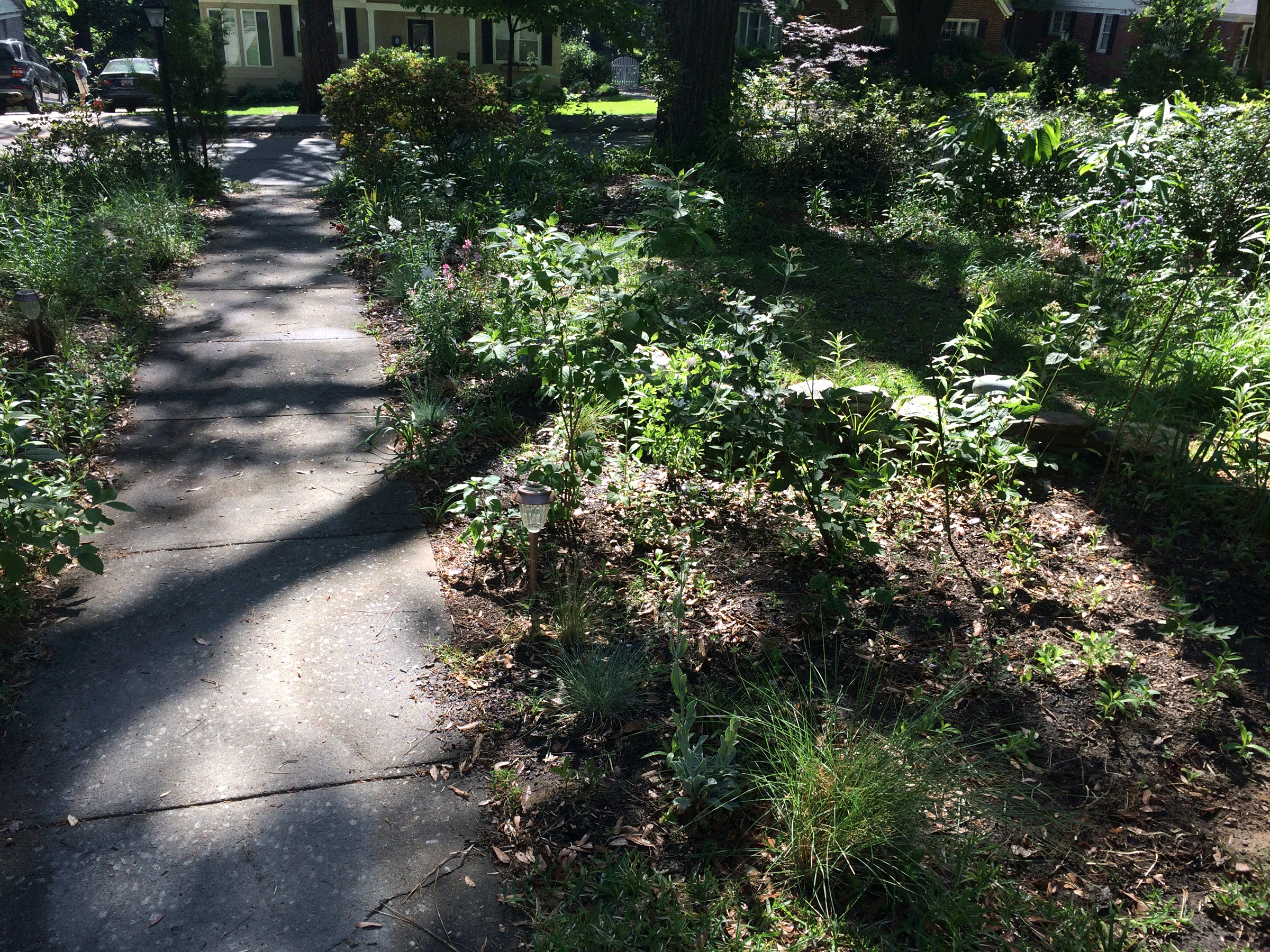
The backyard garden now (photo: Jim Barilla)
CURWOOD: John Holdren is the science advisor to President Obama, and he says he prefers the term "climate disruption" to climate change or global warming. What do you think about that?
BARILLA: Well, it is a disruption to business as usual. This winter, I sort of found myself, like the plants and the bees and the other creatures in the yard, I was sort of thinking, this is clearly a disruption. This is clearly bewildering. What's been interesting to me in the aftermath is to see, well, the impact at least in the short term, plants have come back...it isn't apocalyptic yet, and I think there's a lot of work to be done to make sure that it doesn't become a sort of apocalyptic scenario and remains a disruption so I think we need to figure out how we can embrace and guide that change that becomes as minor a disruption to life as we know it as possible.

Bees thrive on goldenrod (photo: Jim Barilla)
CURWOOD: Jim Barilla is a writer whose new book My Backyard Jungle: The Adventures of an Urban Wildlife Lover Who Turned His Yard into Habitat and Learned to Live with It. Thanks for joining us, Jim.
BARILLA: Thanks. It's been great. Thank you very much for having me.
Related link:
Check out Jim Barilla’s book on his website
Bittersweet Nightshade

(Photo: Kurt Stüber)
CURWOOD: Well, as Jim Barilla suggests, some plants that might not be native to an area may still be useful additions. But others manage to become total pests, think of kudzu and Japanese Knotweed. Some invaders are less problematic, like bittersweet nightshade, a vine with pretty purple flowers and inedible red berries. Now scientists are trying to work out exactly how and why invaders like this find success, as Ari Daniel reports from Cleveland Ohio.
DANIEL: Have you ever wondered what makes an invasive species set up shop somewhere it doesn’t belong? In other words...
BURNS: Why are some species able to invade, and others are not?
DANIEL: Jean Burns is an ecologist at Case Western Reserve University, and her research is offering a clue to that riddle, and also helping to determine which places are most vulnerable to species invasions.
[OUTDOORS, RAIN SOUNDS]
On a cold, rainy morning Burns offered to tell me more on a farm that’s become her outdoor la-boratory outside of Cleveland, Ohio. She spends a lot of time here, examining what seems like a simple question.
BURNS: Where do organisms live, and why this place and not that place?
DANIEL: And although the question is simple, the answer, and the implications of that answer, are anything but. Let’s start with where her organisms of choice – plants – and where they put down their roots – the dirt. She kneels down, and rubs a moist handful between her fingers.
BURNS: So what we see, as humans – it’s brown, it’s muddy – it looks to us like a nice tilled field that’s pretty uniform. But from the perspective of, say, a seedling that’s germinating in a little patch of that soil, what that seedling is experiencing is the bacteria and the fungi that are right next to it in the soil.
DANIEL: Those bacteria and fungi aren’t spread out evenly. Drop one seed at your toes, and toss another one a few feet away, and the seeds may find themselves in vastly different worlds of dirt. To a seed, that can mean the difference between germination and decomposition. That’s because the bacteria and fungi interact with the plants, sometimes helping, sometimes hurting.
And Burns wants to know how these tiny dynamics in the dirt add up to determine why invasive plants grow where they grow when they do.
BURNS: Invasive species are species that have come from somewhere else, and they have be-come often really problematic in the places where they invade.
DANIEL: Burns has a pretty clever experiment underway to figure out what makes certain patches of soil vulnerable to plant invasion or not. To see the set up, we head indoors, inside her lab on the other side of the farm.
[SOUND OF TOOTHPICKS DUMPED ON BENCH]
Ecologist Angela Brandt dumps out a box of plastic party toothpicks onto a table. She’s gluing a tiny seed to each one.
Brandt: Yeah, it’s a good downtime rainy day activity.
DANIEL: So what kind of seed is that?
Brandt: This is Solanum dulcamara, commonly known as bittersweet nightshade. It’s an orna-mental vine – it has very beautiful purple flowers and red berries. And it’s not native to North America.
DANIEL: In fact, none of the seeds in this study are from here. They’re all invasive and by the end of the experiment, this team of ecologists will have glued over 100,000 seeds from these plants to individual party toothpicks. That’s step one. Step two happens back outside on the farm.
[OUTDOORS, RAIN, BIRDS]
Nestled in the dirt are a series of large plastic pots, each one containing a spray of those plastic toothpicks sticking into the ground. Burns crouches down beside one of the pots with a healthy horsenettle plant.
BURNS: Ah, this is an excellent example where you see this plant is right next to that toothpick because that seed was glued on there.
DANIEL: The horsenettle was planted first. Then Burns added seeds of a different species. In this pot, that second species – the bittersweet nightshade – is just emerging from the soil. So the second plant is invading the first one. And if the flip is true too – if the first can invade the se-cond, then it’s a sign of coexistence.
And this ties in to the whole notion of invasive species because when they first appear on the scene, there are, by definition, very few of them. They’re arriving in a place where the odds are against them. But a successful invasive...
BURNS: ...it’s able to germinate and to grow and to persist. That’s basically what invaders have to do when they’re introduced to a native community that’s already established, and they have to be able to overcome that competitive disadvantage.
DANIEL: Burns’ research may help us get smarter about how to prevent, or at least slow down, species invasions. Down the line, she’s hoping to ID the specific bacteria species that promote certain plants to establish themselves in the soil.
But that’s not all. Burns says her work can also inform how we restore places transformed by people. Take a nearby patch of land that’s just been turned over to the Cleveland Metroparks.
BURNS: It’s a golf course. It’s been a golf course for a hundred years. And what they would like to do is restore it into a native maple hardwood forest. And one of their questions, then, is how do they need to treat that soil in order to make their restoration plan really work?
DANIEL: It’s the kind of riddle that Burns’ research might just solve. By exploring how a bunch of invasive plants are duking it out – each with their own microscopic army in the dirt – she’s coming to understand how to put back the plants that used to stand guard here in the first place.
DANIEL: For Living on Earth, I’m Ari Daniel.
CURWOOD: Our story on invasive bittersweet is part of the series, One Species at a Time, pro-duced by Atlantic Public Media, with help from the Encyclopedia of Life.
[MUSIC: Jenny Scheinman “Debra’s Waltz” from The Littlest Prisoner (Sony Music 2014)]
CURWOOD: Coming up...We may be living in a time of widespread extinctions, but that doesn’t mean nature has stopped striving for more forms of life. That's just ahead on Living on Earth. Stay tuned.
ANNOUNCER: Funding for Living on Earth comes from the Grantham Foundation for the protection of the environment. Supporting strategic communications and collaboration in solving the world’s most pressing environmental problems. The Kendeda Fund, furthering the values that contribute to a healthy planet, and Gilman Ordway for coverage of conservation and environmental change. This is PRI, Public Radio International.
[CUTAWAY MUSIC: Various Artists/The Weaseltones: “Life On Mars” from Ziggy Played Surk Guitar (Alan Jenkins Music 2000)]
Evolution in the Age of Mass Extinction
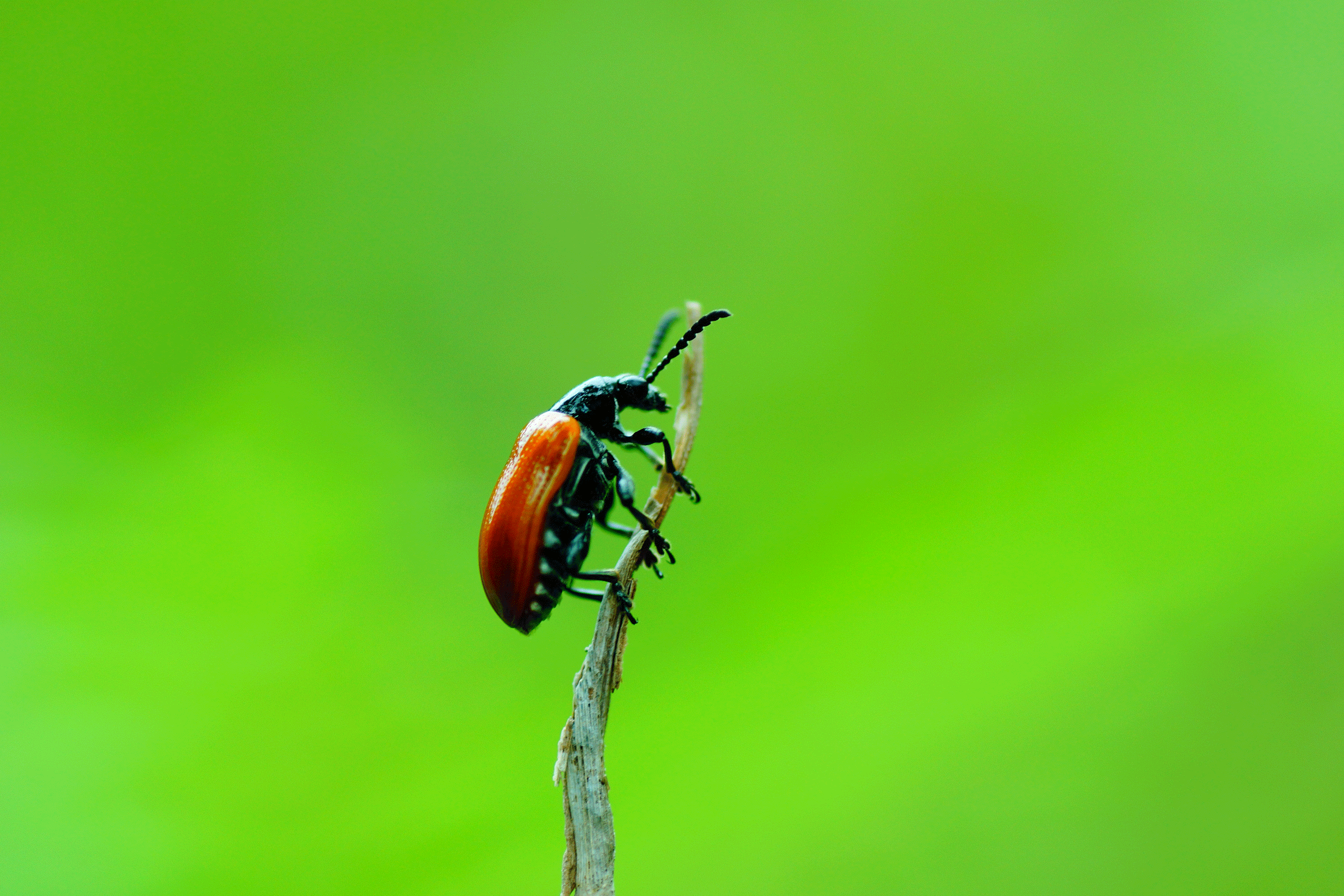
The Scarlet Lily Beetle is reviled by gardeners for eating lilies. But it’s a beautiful bug in its own right! (photo: Vengolis, Creative Commons 3.0)
CURWOOD: It's Living on Earth, I'm Steve Curwood. Many scientists believe that the Earth is undergoing mass extinction number six, this time not due to a random meteor, but at the hands of humanity. So the other day we reached out to Chris Thomas, an evolutionary biologist at York University in the UK because we'd read that he sees some positive aspects in these grim circum-stances. And Chris Thomas joins us now on the line from England. Welcome to Living on Earth.
THOMAS: It's a pleasure to talk to you.
CURWOOD: What do you think of the idea that we're entering a major extinction period?
THOMAS: I think that's very likely. We're seeing unprecedented extinction rates at the moment, and the rates at which we're changing the planet's climate, altering the world's vegetation to pro-duce our food, which obviously we need, polluting with nitrogen. So you see these effects all over the planet, and although they seem quite gradual in a way, if you sit back and think, "Well, humans have been around for a while, suppose they're around for another few hundred years to a few thousand years", just the rates of change you see at the moment are enough to cause a fairly major extinction event.
CURWOOD: But you put a silver lining on this black cloud.
THOMAS: Well, it's a slightly dull silver lining in the sense that a lot of this is going to take place long after we're buried and forgotten, I suspect. Well, what I see is that as we change the environment right across the world, this produces new opportunities for some of the species that exist now, and also provides new opportunities for new things to evolve that will be able to make use of the new environments that we're creating. So just as we see a mass extinction that appears to be emerging because of us, because of our activities, similarly we may see a huge sort of orig-ination and explosion, if you like, of new ecosystems and new species that arise into the envi-ronments that we have changed.
CURWOOD: To what extent are we seeing this growth of biological diversity right now?
THOMAS: Surprisingly, a huge amount. But generally, we almost don't see it as that. We think, well, it's changed from how it was in the past, therefore it's bad, and therefore we see it almost as a loss even when it’s a gain in front of our eyes. So there are two kinds of process that are really giving rise to this. First is what I call ecological diversification, and the second is the evolution-ary diversification.
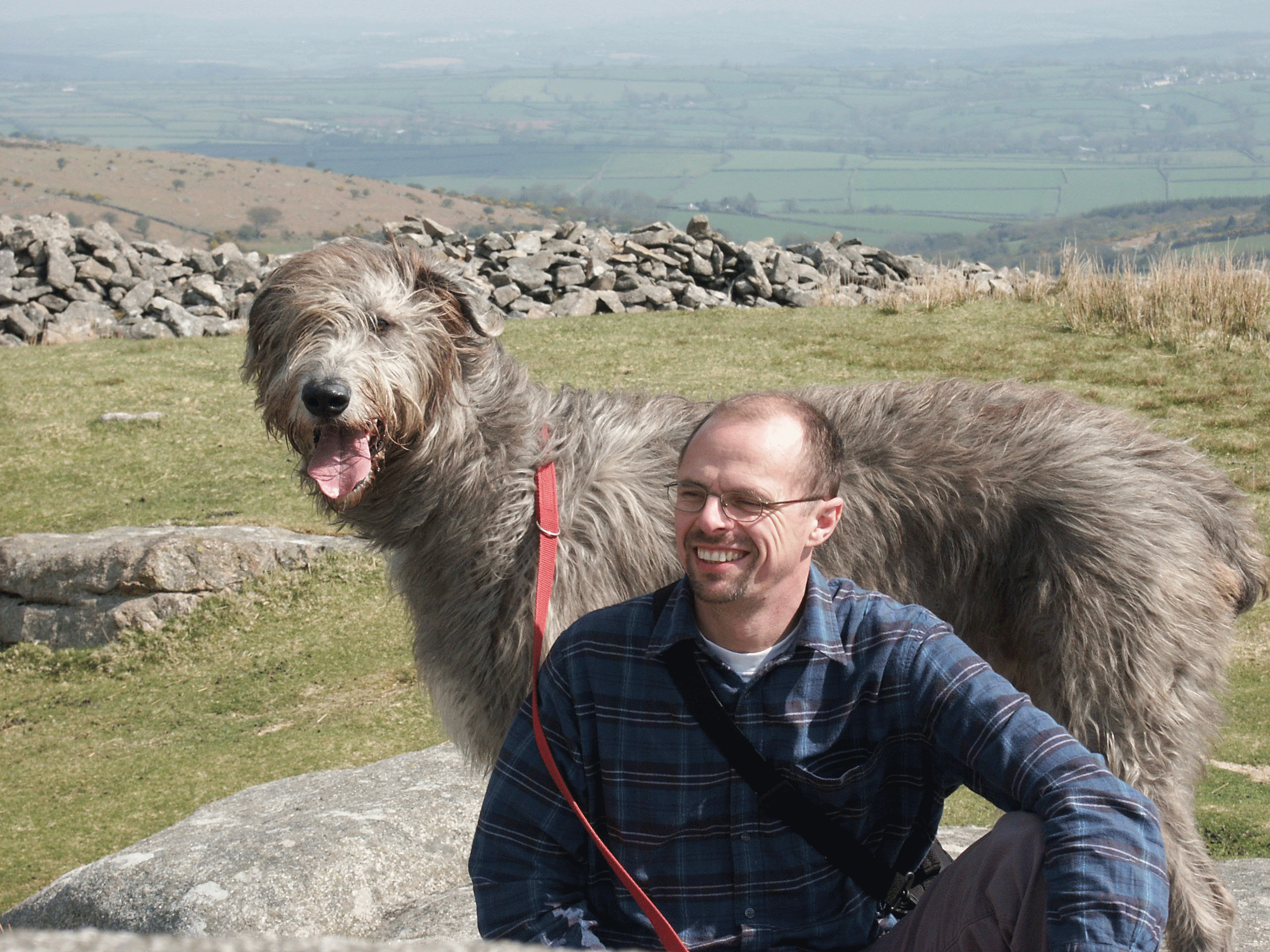
Chris Thomas and his dog Rex (photo: Alice Thomas)
CURWOOD: Alright. Explain these to us. What do you mean by ecological diversification?
THOMAS: So ecological diversification. If you start off in an originally forested landscape, and you turn half of it into pastures, then you provide new ecological opportunities for species that like open habitats to live in that area. So although the diversity of the forest doesn't go up, it probably goes down a bit, the total diversity of the region can actually increase, because you've now got several types of habitat where you used to have just one. The other major effect that we're having is through introducing species to new parts of the world. In Britain, we've had be-tween 1,500 and 2,000 species added to particularly on the plant side, but the animals and plant diversity of Britain is now higher than it used to be. Now the remarkable thing is that none of the native species have actually died out completely from Britain as a result of these new arrivals, so the whole diversity of the country is now much larger.
CURWOOD: So a bit of immigration leads to some more diversity, huh?
THOMAS: Yes, but it's not all positive. So if you introduce mammalian predators, rats and cats and things like that along with humans, to oceanic islands where all the species there have never met a mammalian predator before in their evolutionary history, these predators arrive and the native birds and so on simply don't know what to do them, and they get driven to extinction very fast. So it isn't a universal thing, but on average, when you add a new species to a region, you tend to have a net increase in number of species because for every new species that you add, less than one of the existing species dies out.
CURWOOD: Let's talk about the evolutionary side of this. Talk to me about some of the new species, or some of the broader biological diversity that we're seeing right now.
THOMAS: Well, I can give you almost a little sort of mini-historical story where botanical col-lectors collected something which subsequently became known as Oxford Ragwort. It was a plant, a yellow flower, a plant related to the daisies and to ragwort itself which grew on Mount Vesuvius in Italy. And they brought it back and they cultured it in the botanical garden, and it took a very long time to gradually spread through the city of Oxford.
But eventually it did, and it likes growing in disturbed places so the city is quite a good place for it, and eventually it got to the railway station. Once it got to the railway station, all hell let loose because the seeds are very light. They can be blown in the wind. And they got caught in the vor-tices behind the trains, and they were moved from station to station because it likes stony ground and disturbed places. All the railway stations it turned up at were themselves ideal locations for this plant to grow, so it just spread around the country. And it was living in a habitat where there were no real native species living there, so it was just adding to the country's biodiversity without causing any damage.
But then what happened was it in a few places it ended up hybridizing with groundsel which is sort of a distantly-related species but they can hybridize, and at least three of these hybrids ended up becoming sufficiently genetically distinct that you can now think of them as species in their own right. So we've now got four new ragwort-groundsel species and they've added to British diversity and in fact through these hybridizations they've added to world diversity.
CURWOOD: You've talked about flora, what about fauna, what about animals that are changing right in front of our eyes?

The Tuatara is one of the most genetically distinct species on earth. Chris Thomas thinks that species like this should be of top priority when it comes to saving (Knutschie, public domain)
THOMAS: Yes, so there's a couple of native plant feeding insects in North America which it turned out hybridized. Now, these hybrids were able to live on introduced and so-called invasive European honeysuckles. So this species has now spread and so we've added one more species of insect to the world, and it's feeding on a plant that people thought was a bit troublesome. And so it's probably rather a good thing.
CURWOOD: Have you found any new insects that like kudzu?
THOMAS: You can pretty much guarantee that any plant that's causing a problem somewhere is going to have some native species within its historical range that's capable of feeding on it. And this, of course, is the basis for biological control programs. Of course, sometimes, when we in-troduce plants, the insects arrive and then people don't like them. We've got a beautiful lily beetle which I believe has colonized North America as well as northern Europe that feeds on garden lilies and to me as an insect ecologist it’s an absolutely beautiful insect, this orangey color, but it does rather devastate your prize lilies, and so gardeners are very upset about this.
Some species, when they arrive, if people sort of hate them, others if they think they're bio-control because it's reducing something you don't like, they're great things, but they're just spe-cies. So, I'm not really saying any of this is good or bad, what I'm observing is that if we look across the planet both through the ecological processes of insects following the plants that they eat on, hybridization, species just evolving when new opportunities arise that they can exploit, that what we're starting to see is this emergence of a new diversity which is rather strongly associated with human activities.
CURWOOD: So, what's you take on then on the whole concept of invasive species, and the fear that people tend to have around them? I'm wondering if you see this as perhaps just a fear of change, a desire to just keep things the way they are when maybe in your view nature doesn't work that way?
THOMAS: Well, in the long run, nature absolutely does not work in that way. I know most people think that 21,000 years ago is rather a long time ago, but in terms of the history of life on Earth, it's not even yesterday. You can imagine yourself back to 21,000 years ago in the middle of the last ice age, almost none of the species that you would see where you are right now would be the same. The whole of the new vegetation where all the animals are now is new compared to what it was just 21,000 years ago. And so, if you start thinking about invasive species, well, everything is an invasion on this time scale.
CURWOOD: Professor, what do you think of what we're seeing around the world in terms of these dramatic and sometimes heroic efforts to save particular species of plants and animals. I'm thinking in particular of scientists in the Arctic that have begun to advocate for human feeding of wild Polar bears. What do you think about things like that?
THOMAS: I think it's not a bad holding position, let's say. We are driving lots of species extinct. The difficulty is though that we tend to choose the most spectacular to take these actions for, most of the species that are going extinct are insects, plants that are very rare, many of which would just disappear and hardly anyone would notice.
So I'm all in favor of trying to maintain wild populations of species particularly if there's some hope that these species might be able to make a go of it again without having to take these interventions. So if it's a holding operation for 100 years or so, then fine. If it's absolutely indefinite, well, one's got to ask what should we prioritize in terms of saving.
And, for that, I would argue we should be thinking particularly about things that are evolutionarily very very distinct. So something like a Tuatara from New Zealand, which is a kind of reptile, it kind of looks like a regular big lizard but actually, evolutionarily it's almost as different as the lizards and the dinosaurs are from one another. This is a bit of our evolutionary history, and I would strongly advocate for keeping those organisms alive and the genetic knowledge that is associated with them.
CURWOOD: So, in the context of climate disruption, people are pointing to a lot of plants and animals that are going to go away and kind of quickly. Should we attempt to save as much as we can, or essentially roll with it?
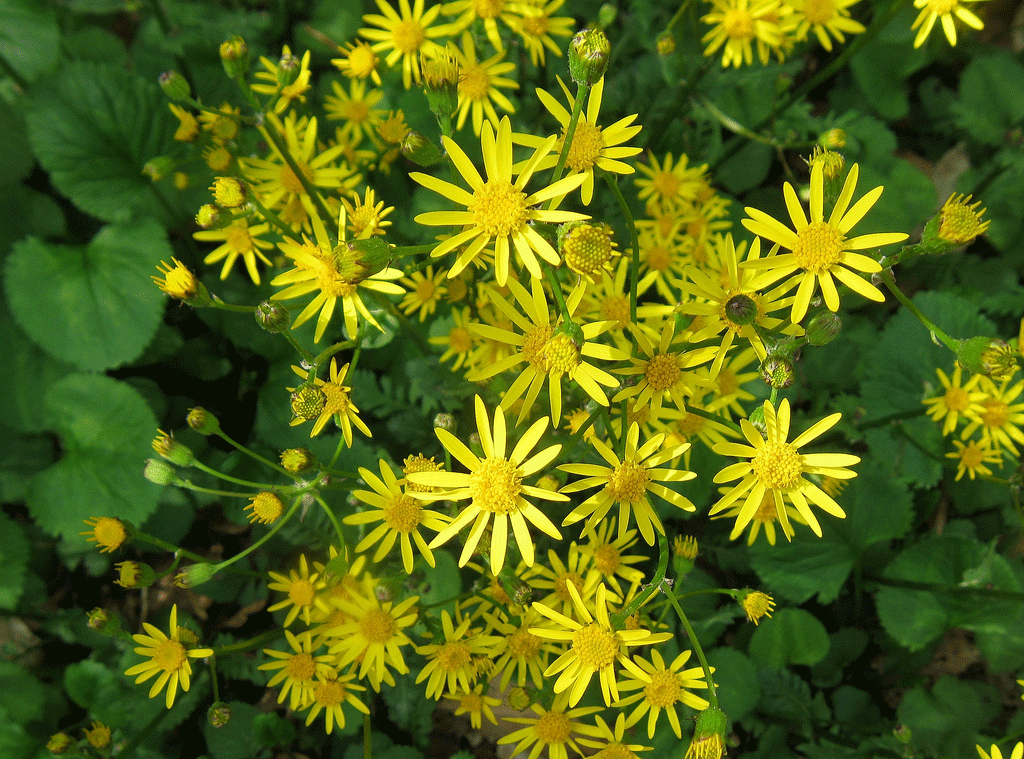
Common groundsel (pictured above) has hybridized with Vesuvius Ragwort to create a new species in Britain (photo: Pauline Rosenberg, Creative Commons 2.0)
THOMAS: Environmental change is absolutely inevitable. It's been going on steadily for the last century, in fact, it's been going on for much longer than that, and I think what we should be thinking about in an environmental context is how we live with that change rather than our start-ing point simply and always be to try and keep things exactly as they are or go back to some im-agined past type of ecosystem. It isn't going to be done. We're going to lose if that is our ap-proach.
If we try to keep things the way they were, then for example, as the climate changes, helping species move to new areas where they may be able to thrive in the future, would be off the agen-da because that would be making things less like the past. But it may still be saving species. And these more flexible approaches are maximizing opportunities as well as minimizing harms. I would think that's the way to go.
CURWOOD: Some people listening to you might say that you're saying, hey, everything's going to be OK. We could keep on going because nature's going to evolve and adapt and we shouldn't worry. To what extent are you concerned that people are going to take your message as license to keep on polluting, just keep on consuming?
THOMAS: That's not what I feel. I think if we end up wiping out, say, a quarter of the species, maybe slightly more, I think from an individual personal perspective that's a tragedy. I think from some sort of a utilitarian perspective, it's one hell of a waste of biological material that might have been of use to humanity at some point in the future, so I think it's a kind of madness, I think it's a shame.
What I'm really saying is that as we're living through what appears to be mass extinction caused by us, it's also extremely interesting to see just the beginnings of the shoots of recovery. It's not necessarily all rosy whatsoever, but it is a very interesting evolutionary and ecological phenome-non that as we modify and transform the planet in a enormous number of ways, the biological diversity is ready to give it a go of seeing what it can do with these new conditions.
CURWOOD: Chris Thomas is a Professor of Conservation Biologist at University of York in the UK. Thanks so much, Professor, for joining us.
THOMAS: You're very welcome.
Related link:
Chris Thomas teaches biology at the University of York
[MUSIC: Compost “Mon Cherry Popsicool” from Life Is Round (Sony Music 1973)]
Beyond the Headlines

CURWOOD: Finally today, our weekly walk beyond the headlines with Peter Dykstra. As well as talking to us, he publishes DailyClimate.org and Environmental Health News - EHN.org. He's on the line from Conyers, Georgia, now. Hi, Peter, what's up?
DYKSTRA: Hi, Steve. Here’s a pretty cool story that’s been playing out for several years. Back in 2011, one of our reporters at Environmental Health News, Brett Israel, filed a story on bro-minated vegetable oil, or BVO.
CURWOOD: And what does brominated vegetable oil, or BVO do?
DYKSTRA: Well, it depends where you live. Here in the US, BVO is an additive in some fruit flavored soft drinks, and in Europe and Japan, you're not allowed to use it in food, but you can as a flame retardant chemical additive.
CURWOOD: Get out. So you're saying it’s foodstuff here and a firestopper elsewhere?
DYKSTRA: Yeah, and here, as of back then, 2011, it was in Gatorade, Powerade, Mountain Dew and a whole lot of citrus-based drinks as an emulsifier, that sort of holds the flavorings to-gether so you don’t have water at the top of the bottle and flavoring at the bottom. When Brett did this story for us it struck a nerve with a 15-year-old in Mississippi named Sarah Kavanaugh. She read the story, started a petition on the Change.org website, and 200,000 signatures later, Pepsi announced it would remove brominated vegetable oil from all of its Gatorade products. Sarah turned her sights on Coca-Cola, which owns the Powerade brand, and this week Coke con-firmed it’s quitting BVO as well.
CURWOOD: Sounds like a big victory for consumer concerns, but what to we really know about brominated vegetable oil?
DYKSTRA: Well, companies like Coke and Pepsi say it’s safe, even though they’ve just gotten rid of it due to consumer concerns. The FDA has given it “Conditional Approval” for use in food, in fact, they gave it conditional approval 30 years ago and that's where it stayed, sort of in a food limbo, and some studies have shown health risks with fairly large levels of consumption. But BVO is patented as a flame retardant.
CURWOOD: Maybe that’s why football coaches don’t burst into flames when they get the buck-et of sports drink dumped on them at the end of a winning game! Next story, Peter?
DYKSTRA: OK. There are pipeline projects crossing Canada that are just as contentious as the Keystone XL pipeline is here in the US. Last week, a prospective pipeline builder, Kinder Mor-gan, got a little too enthusiastic about the value of pipelines.
CURWOOD: A little over the top. How?
DYKSTRA: They submitted a report to the Canadian Federal government on a pipeline it hopes to expand to carry the tarsands in Alberta to Canada’s West Coast, and one of the economic ben-efits they say comes from pipelines, is how much money people might make cleaning up tar sands oil spills. They said that spills “create business and they create employment opportuni-ties.”
CURWOOD: Isn’t that a little like saying cigarettes and car wrecks are good business for the fu-neral industry?
DYKSTRA: Yes, people in the vicinity of an oil spill are always really thankful for it.
CURWOOD: I'm sure they are. Hey, Peter, what’s on the calendar this week?
DYKSTRA: Seven years ago this week, one of the world’s greatest news and media empires threw down the gauntlet on climate change. The media mogul in charge brought in all of the ex-ecutives and told them, and this is his quote - “Climate change poses clear, catastrophic threats. We may not agree on the extent, but we certainly can’t afford the risk of inaction.”
CURWOOD: OK, Peter, what's the name of this tree-hugging media tycoon?
DYKSTRA: Sir Rupert Murdoch.
CURWOOD: Come on! Really? You’re telling me that the guy who owns Fox News and the Wall Street Journal thinks climate change is a big deal?
DYKSTRA: Yes, and he committed their parent company, News Corporation to "dramatically reduce their carbon footprint". It made a fair amount of news at the time, but I don’t think it made Fox News or the Wall Street Journal, or the Simpsons, which he also owns.
CURWOOD: So doing something about climate change while your global news empire says it doesn’t exist. Is that what they mean by “fair and balanced?”
DYKSTRA: Watch yourself with that “fair and balanced” talk. Those words are registered as a trademark by Sir Rupert’s company.
CURWOOD: You can find these and other links to our stories at LOE.org.
DYKSTRA: But you won't find it the News Corp site. It was taken down a couple of years ago.
CURWOOD: Peter Dykstra is Publisher of Environmental Health News, that's EHN.org, and DailyClimate.org. Thanks so much, Peter.
DYKSTRA: Thanks a lot, Steve. Talk to you soon.
Related links:
- Environmental Health News
- The Daily Climate
[MUSIC: Monty Alexander “Sneaky Steppers” from Yard Movement (Island records 1996)]
CURWOOD: Living on Earth is produced by the World Media Foundation. Naomi Arenberg, Clairissa Baker, Bobby Bascomb, Emmett Fitzgerald, Helen Palmer, Catalina Pire-Schmidt, Ad-elaide Chen, James Curwood and Jennifer Marquis all help to make our show. Jeff Turton is our technical director. Alison Lirish Dean composed our themes.
You can find us anytime at LOE.org, and like us on our Facebook page - it’s PRI’s Living on Earth. And we tweet from @LivingOnEarth. I'm Steve Curwood. Thanks for listening.
ANNOUNCER 1: Funding for Living on Earth comes from the Grantham Foundation for the protection of the environment. Supporting strategic communications and collaboration in solving the world’s most pressing environmental problems. The Kendeda Fund, furthering the values that contribute to a healthy planet, and Gilman Ordway for coverage of conservation and environ-mental change. Living on Earth is also supported by a friend of Red Tomato, supplier of righteous fruits and vegetables from northeast family farms. www.redtomato.org. This is PRI, Public Radio International.
ANNOUNCER 2: PRI, Public Radio International.
Living on Earth wants to hear from you!
Living on Earth
62 Calef Highway, Suite 212
Lee, NH 03861
Telephone: 617-287-4121
E-mail: comments@loe.org
Newsletter [Click here]
Donate to Living on Earth!
Living on Earth is an independent media program and relies entirely on contributions from listeners and institutions supporting public service. Please donate now to preserve an independent environmental voice.
NewsletterLiving on Earth offers a weekly delivery of the show's rundown to your mailbox. Sign up for our newsletter today!
 Sailors For The Sea: Be the change you want to sea.
Sailors For The Sea: Be the change you want to sea.
 The Grantham Foundation for the Protection of the Environment: Committed to protecting and improving the health of the global environment.
The Grantham Foundation for the Protection of the Environment: Committed to protecting and improving the health of the global environment.
 Contribute to Living on Earth and receive, as our gift to you, an archival print of one of Mark Seth Lender's extraordinary wildlife photographs. Follow the link to see Mark's current collection of photographs.
Contribute to Living on Earth and receive, as our gift to you, an archival print of one of Mark Seth Lender's extraordinary wildlife photographs. Follow the link to see Mark's current collection of photographs.
 Buy a signed copy of Mark Seth Lender's book Smeagull the Seagull & support Living on Earth
Buy a signed copy of Mark Seth Lender's book Smeagull the Seagull & support Living on Earth

